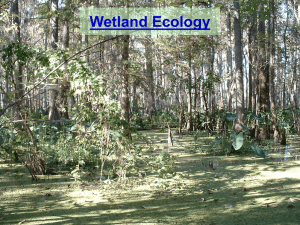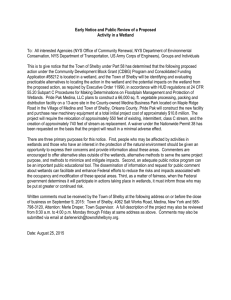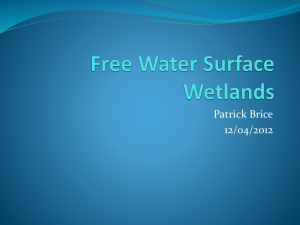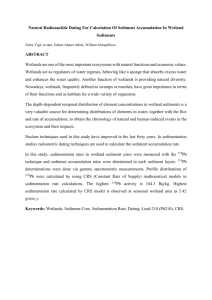CONSTRUCTED WETLANDS-simon-2015
advertisement
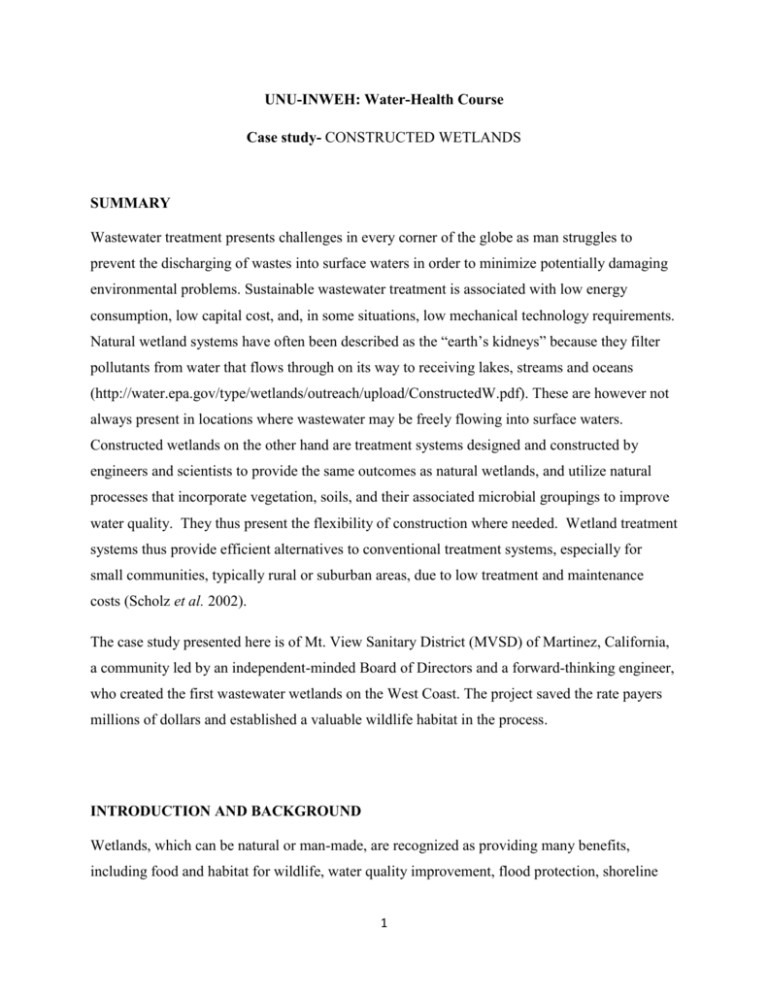
UNU-INWEH: Water-Health Course Case study- CONSTRUCTED WETLANDS SUMMARY Wastewater treatment presents challenges in every corner of the globe as man struggles to prevent the discharging of wastes into surface waters in order to minimize potentially damaging environmental problems. Sustainable wastewater treatment is associated with low energy consumption, low capital cost, and, in some situations, low mechanical technology requirements. Natural wetland systems have often been described as the “earth’s kidneys” because they filter pollutants from water that flows through on its way to receiving lakes, streams and oceans (http://water.epa.gov/type/wetlands/outreach/upload/ConstructedW.pdf). These are however not always present in locations where wastewater may be freely flowing into surface waters. Constructed wetlands on the other hand are treatment systems designed and constructed by engineers and scientists to provide the same outcomes as natural wetlands, and utilize natural processes that incorporate vegetation, soils, and their associated microbial groupings to improve water quality. They thus present the flexibility of construction where needed. Wetland treatment systems thus provide efficient alternatives to conventional treatment systems, especially for small communities, typically rural or suburban areas, due to low treatment and maintenance costs (Scholz et al. 2002). The case study presented here is of Mt. View Sanitary District (MVSD) of Martinez, California, a community led by an independent-minded Board of Directors and a forward-thinking engineer, who created the first wastewater wetlands on the West Coast. The project saved the rate payers millions of dollars and established a valuable wildlife habitat in the process. INTRODUCTION AND BACKGROUND Wetlands, which can be natural or man-made, are recognized as providing many benefits, including food and habitat for wildlife, water quality improvement, flood protection, shoreline 1 erosion control, and opportunities for recreation and aesthetic appreciation (US EPA 1993, http://www.epa.gov/owow/wetlands/pdf/ConstructedWetlands-Complete.pdf). They contain a great diversity of plant and animal species and are of significant importance in locations where they are located. According to the Ramsar Convention on Wetlands; “Wetlands are areas of marsh, fen, peat or water, whether natural or artificial, permanent or temporary, with water that is static or flowing, fresh, brackish or salt, including areas of marine water the depth of which at low tide does not exceed six metres." (http://www.wetlands.org/Whatarewetlands/tabid/202/Default.aspx). Water filtration is one of their greatly notable functions. Due to the presence of fauna and flora, water slows down as it flows through, causing many of the suspended solids to become trapped and settle out. Other pollutants are transformed to less soluble forms taken up by plants or become inactive. Wetland plants also foster the necessary conditions for microorganisms to live there by providing the structure needed for biofilm bacteria to process wastewater (http://californiaagriculture.ucanr.edu/landingpage.cfm?article=ca.v065n02p73&fulltext=yes). Through a series of complex processes, these microorganisms also transform and remove pollutants from the water (http://water.epa.gov/type/wetlands/outreach/upload/ConstructedW.pdf). The treatment efficiencies of wetlands vary depending on the wetland design, type of wetland system, climate, vegetation, and microbial communities (Vacca et al. 2005). CONSTRUCTED WETLANDS Constructed wetlands treatment systems are secondary treatment facilities, which generally fall into one of two categories of either Subsurface Flow Systems or Free Water Surface Systems. Both types of wetlands treatment systems typically are constructed in basins or channels with a natural or constructed subsurface barrier to limit seepage (USEPA) Subsurface Flow Systems (SF) (Figs 1a and b). http://ucce.ucdavis.edu/files/repository/calag/fig6502p75thumb.jpg) (http://californiaagriculture.ucanr.edu/landingpage.cfm?article=ca.v065n02p73&fulltext=yes). 2 Subsurface Flow Systems are designed to create subsurface flow through a permeable medium, keeping the water being treated below the surface, thereby helping to avoid the development of odors and other nuisance problems. Such systems have also been referred to as "root-zone systems," "rock-reed-filters," and "vegetated submerged bed systems." The media used (typically soil, sand, gravel or crushed rock) greatly affect the hydraulics of the system. (US EPA). SF wetland systems are best suited for small to moderate sized applications and at larger systems where the risk of public contact, mosquitoes, or potential odors is a major concern. SF wetlands remove BOD (biochemical oxygen demand), COD (chemical oxygen demand), and TSS (total suspended solids), and with sufficiently long retention times can also produce low levels of nitrogen and phosphorus (When too much nitrogen and phosphorus enter the environment usually from a wide range of human activities - the air and water can become polluted). Free Water Surface Systems (FWS). (Fig 2). http://www.sswm.info/category/implementation-tools/wastewater-treatment/hardware/semicentralised-wastewater-treatments/f Free Water Surface Systems are designed so that the water surface is exposed to the atmosphere. In this system, vegetation is planted in base soils below water as deep as 4 feet (Fig. 2, http://californiaagriculture.ucanr.edu/landingpage.cfm?article=ca.v065n02p73&fulltext=yes). They are designed to simulate natural wetlands, with the water flowing over the soil surface at shallow depths. Most natural wetlands are FWS systems, including bogs (primary vegetation mosses), swamps (primary vegetation trees), and marshes (primary vegetation grasses and emergent macrophytes.). The influent (Influent streams do not usually get deeper and wider downstream) to these wetlands spreads over a large area of shallow water and emergent vegetation. The subsequent low velocity and essentially laminar flow provides for very effective particulate removal in the front part of the system. This particulate material, characterized as total suspended solids (TSS), contains Biochemical Oxygen Demand (BOD) components, fixed forms of total nitrogen (TN) and total phosphorus (TP), and trace levels of metals and more complex organics. The oxidation or reduction of these particulates releases soluble forms of BOD, TN, and TP to the wetland 3 environment, which are available for adsorption by the soils and removal by the active microbial and plant populations throughout the wetland (USEPA 2000). WASTEWATER WETLANDS, MT. VIEW SANITARY DISTRICT, MARTINEZ CALIFORNIA (FWS) Mt. View Sanitary District (MVSD) provides wastewater treatment for approximately 16,000 people living in and around Martinez, California. This community, led by an independentminded Board of Directors and a forward-thinking engineer, created the first wastewater wetlands on the West Coast. The Mt. View Sanitary District marshes are located in an urban environment and the marsh is bisected by an interstate highway. The project saved the rate payers millions of dollars and established a valuable wildlife habitat in the process. In 1974 the District began with a simple 10-acre wetland divided into two sections. The area that was created by scraping away the topsoil became a shallow, open-water pond. The other area, whose topsoil was not disturbed, was quickly colonized by emergent vegetation, such as cattails. In 1977 the marsh was expanded to include 10 more acres of land divided into three marsh areas. One was constructed as an open-water pond with islands to provide protected nesting habitat for waterfowl. A second marsh was seeded with plants to provide food for waterfowl, such as water grass and alkali bulrush (Echinochloa crusgalli and Scirpus robustus). The third area was designed in a serpentine fashion to provide maximum water/plant contact to enhance treatment effectiveness. The next 22 acres, added to the marsh system in 1984, were located across the interstate to the north. This area had been seasonally flooded and the District merely had to make minor changes to water control structures to allow the marsh's inclusion in the system. The most recent addition to the wastewater wetland complex is a 43-acre section that also is located to the north of the interstate and adjacent to the previous 22 acres. The wetlands area totals 85 acres. This bountiful wildlife habitat includes plants, animals, fish and invertebrates. Some of the animals are permanent residents of the marshes, while others are temporary visitors that stop along their migratory journey. Plants grow in the marshes as well as on the levees surrounding the marshes 4 and a riparian corridor (a unique plant community consisting of the vegetation growing near a river, stream, lake, lagoon or other natural body of water) is beginning along Peyton Slough. There are emergent plants rooted in the bottom muds as well as submerged plants. Mt. View Sanitary District provides secondary treatment to approximately 1.3 million gallons per day of wastewater from approximately 16,000 residents in the Martinez, Calif., area. Although there is some light industry and commercial development within the District's service area, the primary source of the wastewater is residential. The District maintains strict pretreatment standards and prohibits the discharge of heavy industrial waste into its sewerage system. (USEPA 1993) FINDINGS According to USEPA 1993: Wetland plants provide food and shelter for marsh biota and improve water quality. Birds, mammals, reptiles and amphibians eat plant leaves, seeds and roots of the more than 70 species of marsh and riparian vegetation. Dense growths of marsh bulrushes provide nesting sites for songbirds as well as ducks. The most visible animals at the marshes are the more than 123 species of birds and more than 15 species of birds that nest in the wetland. Although the primary purpose for constructing the wetland is to create wildlife habitat, it also improves water quality for some parameters. There are numerous processes by which plants contribute to water quality improvements, including direct uptake of nutrients by algae and some rooted vegetation. The plants foster settling of particulate matter by slowing water movement and greatly increase the contact with microorganisms that live on the surfaces of emergent plants. These microorganisms metabolize pollutants, decreasing their dissolved concentrations in the water. Monitoring shows that wetland nutrient concentrations follow a stable seasonal cycle that varies little from month to month, but clearly shows a difference between the cold, wet season (November through April) and the warm, dry season (May through October). The concentration of nitrates decreases in the wetland during the summer months. There is limited evidence to suggest that the wetland is removing cadmium, copper, silver and zinc. In addition, periodic special monitoring studies are undertaken to answer specific questions 5 concerning the processes or biota within the wetlands. Studies at the marsh have included an ammonia study and a fisheries and benthic invertebrate study. Doubtless the largest special study, however, occurred after the 1988 spill of 440,000 gallons of crude oil into the marsh from an adjacent refinery. The cleanup efforts included picking up oily water by vacuum trucks, rototilling of contaminated soils and hand-cutting vegetation in less inundated areas of the marsh. The recovery of the marsh's vegetation and soils was monitored closely and eight months later this section of the wetland resumed operation. CONCLUSION It is clear that constructed wetlands water treatment projects are a positive endeavor, that both improve the quality of wastewater flowing through them and provide habitat/feed wildlife that come to the wetland. They are ecosystems that have evolved to separate the toxins in their water supply and use the elements with nutritional value to grow vegetation and keep the environment healthy. Constructed wetlands are good for the community and environment, provided they are properly constructed and guidelines followed. There are some down sides to the constructed wetlands, i.e. their performances vary depending on the season (better performance in the summer and less in the winter) and they also need several years (i.e. 5 years) of operation to obtain maximum efficiency. REFERENCES CITED 1. http://water.epa.gov/type/wetlands/outreach/upload/ConstructedW.pdf . 2. Scholz M, Höhn P, Minall R (2002) Mature experimental constructed wetlands treating urban water receiving high metal loads. Biotechnol Progr 18:1257–1264 3. US EPA, 1993. http://www.epa.gov/owow/wetlands/pdf/ConstructedWetlandsComplete.pdf 4. (http://www.wetlands.org/Whatarewetlands/tabid/202/Default.aspx). 5. Gabriela Vacca, Helmut Wand, Marcell Nikolausz, Peter Kuschk, Matthias Kästne . 2005. Effect of plants and filter materials on bacteria removal in pilot-scale constructed wetlands. Water Research. Volume 39, Issue 7, Pages 1361-1373 6. Tilley, E.; Luethi, C.; Morel, A.; Zurbruegg, C.; Schertenleib, R. (2008): Compendium of Sanitation Systems and Technologies. Duebendorf, Switzerland: Swiss Federal Institute of Aquatic Science and Technology. 6 (Accessed. http://www.sswm.info/category/implementation-tools/wastewatertreatment/hardware/semi-centralised-wastewater-treatments/f) IMAGES Fig. 1a. Subsurface Flow System (http://ucce.ucdavis.edu/files/repository/calag/img6502p73athumb.jpg) Fig. 1b. Subsurface Flow System (http://ucce.ucdavis.edu/files/repository/calag/img6502p73athumb.jpg) 7 Fig 2. Schematic diagram of a free-water surface constructed wetland. Source: TILLEY et al. (2008)( http://www.sswm.info/category/implementation-tools/wastewatertreatment/hardware/semi-centralised-wastewater-treatments/f) Fig. 3. Martinez, San Francisco Bay Area, California. (http://en.esstatic.us/upl/2012/10/San_Francisco_Martinez.jpg) 8


